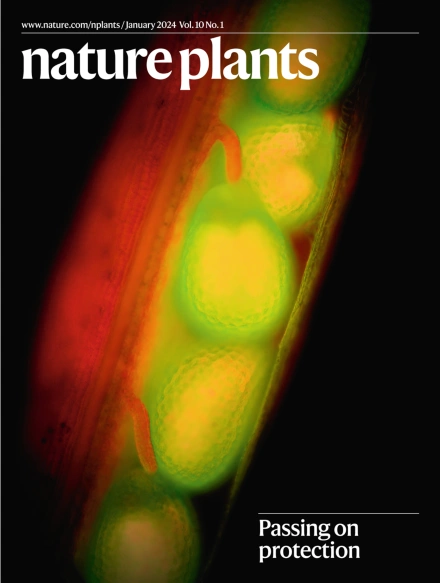Co-option and neofunctionalization of stomatal executors for defence against herbivores in Brassicales
IF 15.8
1区 生物学
Q1 PLANT SCIENCES
引用次数: 0
Abstract
Co-option of gene regulatory networks leads to the acquisition of new cell types and tissues. Stomata, valves formed by guard cells (GCs), are present in most land plants and regulate CO2 exchange. The transcription factor (TF) FAMA globally regulates GC differentiation. In the Brassicales, FAMA also promotes the development of idioblast myrosin cells (MCs), another type of specialized cell along the vasculature essential for Brassicales-specific chemical defences. Here we show that in Arabidopsis thaliana, FAMA directly induces the TF gene WASABI MAKER (WSB), which triggers MC differentiation. WSB and STOMATAL CARPENTER 1 (SCAP1, a stomatal lineage-specific direct FAMA target), synergistically promote GC differentiation. wsb mutants lacked MCs and the wsb scap1 double mutant lacked normal GCs. Evolutionary analyses revealed that WSB is conserved across stomatous angiosperms. We propose that the conserved and reduced transcriptional FAMA–WSB module was co-opted before evolving to induce MC differentiation. The authors identified a transcriptional module, FAMA–WASABI MAKER (WSB), for the development of stomata and idioblast myrosin cells. They propose that the conserved and reduced FAMA–WSB module was co-opted before evolving to induce idioblast development.


芸苔属植物气孔执行器的协同选择和新功能化以抵御食草动物的侵害
基因调控网络的共同选择导致获得新的细胞类型和组织。气孔是由保护细胞(GCs)形成的阀门,存在于大多数陆地植物中并调节二氧化碳交换。转录因子(TF) FAMA是调控GC分化的全局因子。在芸苔属植物中,FAMA还促进异母黑素细胞(MCs)的发育,这是另一种沿着脉管系统的特化细胞,对芸苔属植物的特异性化学防御至关重要。在拟南芥中,FAMA直接诱导TF基因WASABI MAKER (WSB),从而触发MC分化。WSB和STOMATAL CARPENTER 1 (SCAP1,一个气孔谱系特异性的FAMA直接靶点)协同促进GC分化。wsb突变体缺乏MCs, wsb scap1双突变体缺乏正常的GCs。进化分析表明WSB在有气孔被子植物中是保守的。我们提出保守和转录减少的FAMA-WSB模块在进化之前被增选以诱导MC分化。
本文章由计算机程序翻译,如有差异,请以英文原文为准。
求助全文
约1分钟内获得全文
求助全文
来源期刊

Nature Plants
PLANT SCIENCES-
CiteScore
25.30
自引率
2.20%
发文量
196
期刊介绍:
Nature Plants is an online-only, monthly journal publishing the best research on plants — from their evolution, development, metabolism and environmental interactions to their societal significance.
 求助内容:
求助内容: 应助结果提醒方式:
应助结果提醒方式:


